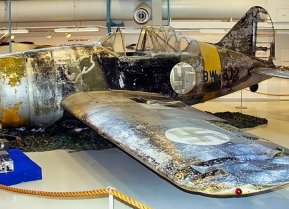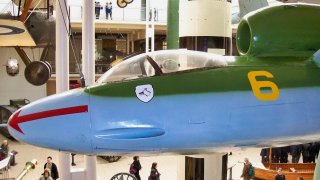Heinkel He 162 Salamander: The Fastest Operating Jet Fighter in World War II
"Salamander," as it turned out, was a terrible nickname for the Heinkel He 162. Still, she was the fastest operating jet fighter in WWII.
As I noted in recent articles on the Messerschmitt Me 262 Schwalbe jet fighter and the Me 163 Komet rocket-powered interceptor, the Germans have long been innovators in weaponry. The Me 262 was quite successful, though it was certainly far from invincible and came along too late to turn the tide of the European air campaign in World War II. The Me 163 had its moments, but it was almost as dangerous to its own pilots as it was to Allied adversaries. However, the Komet was a shining star indeed, compared to Nazi Germany's other jet fighter of WWII, the Heinkel He 162 Volksjäger, or Spatz.
The He 162 Salamander Was No Mosquito
Aircrews often give their own nicknames to their planes. For example, the A-10 Thunderbolt II is better known as the "Warthog," the B-1 Lancer is better known as the "Bone," and the F-16 Fighting Falcon is better known as the "Viper." In the case of the Volksjäger/Spatz, the unofficial sobriquet was "Salamander." The name didn’t refer to any amphibious capabilities, but rather drew upon folkloric myth of the salamander being immune to fire.
This aerial pseudo-amphibian made its maiden flight on Dec. 6, 1944, and was officially introduced into service the following month. It was built by Heinkel Flugzeugwerke, the German aircraft manufacturer best known for building the He-111 heavy bomber that had made life miserable for Londoners during the Battle of Britain.
Unlike its piston-engined predecessor, the jet-propelled He 162 was born of desperation, and that showed in the poor quality of its construction materials. Frantic as enemies pushed in from east and west, Hermann Göring and Albert Speer concocted an Emergency Fighter Program to produce a cut-rate advanced fighter that would not drain the Reich’s ever-dwindling economic resources. In order to cut financial corners, it was decided that this jet plane would be built of wood, and using unskilled labor.
Now, all-wood construction worked out fine for propeller-driven planes that were able to take advantage of skilled labor, such as Britain's De Havilland Mosquito fighter-bomber, or eccentric American billionaire Howard Hughes's Spruce Goose. (Granted, the Spruce Goose only flew once, but at least she remained intact.)
But trying to build a jet fighter on the cheap using slave labor is recipe for disaster. Especially odious was the shoddy acidic glue holding the components together – it had a distressing tendency to eat through the plywood components.
A Suicidal Machine, Not by Design
If there was one thing the Salamander did right, it was speed. It turned out to be the fastest operating jet fighter in World War II. Its maximum speed of 562 miles per hour at high altitude beat the Me 262, the British Gloster Meteor, and the American Bell P-59 Airacomet. Indeed, the only WWII plane to travel faster was the Komet at 596mph.
The Salamander also broke ground as the first working jet fighter to feature an ejection seat, using an explosive cartridge under the pilot’s chair to blast him out of the cockpit. Finally, it was the only single-engine Axis plane that had tricycle landing gear. (It had this in common with America's prop-driven P-39 Airacobra.)

However, the bad definitely outweighed the good. The He 162 developed a reputation for spontaneously combusting in midair. (So much for the legend of the fireproof Salamander.) It was limited to 30 minutes' worth of endurance, lacked maneuverability and stability, required long runways for takeoff, and was prone to shaking violently when firing its 30mm cannon.
To make matters even worse, while the Nazis didn't employ outright suicide pilots like Emperor Hirohito's kamikazes, they tried to do the next worst thing, which was to recruit inexperienced but highly indoctrinated Hitler Youth as pilots. That didn't work, so instead the planes were sent to the veteran fighter group Jagdgeschwader I. These Luftwaffe pilots, in spite of their experience, got maybe two unconfirmed kills in exchange for the loss of 13 Salamanders and nine pilots, including the unit commander.
He 162: Where Are They Now?
Roughly 320 of these shoddy jet fighters were built, out of 4,000 planned, but only 116 were actually delivered. Miraculously, eight of them survive in museums today, including the Canada Aviation and Space Museum in Ottawa and the Planes of Fame Museum in Chino, California.
About the Author
Christian D. Orr is a former Air Force officer, Federal law enforcement officer, and private military contractor (with assignments worked in Iraq, the United Arab Emirates, Kosovo, Japan, Germany, and the Pentagon). Chris holds a B.A. in International Relations from the University of Southern California (USC) and an M.A. in Intelligence Studies (concentration in Terrorism Studies) from American Military University (AMU). He has also been published in The Daily Torch and The Journal of Intelligence and Cyber Security. Last but not least, he is a Companion of the Order of the Naval Order of the United States (NOUS).
All images are Creative Commons.


